Damning documents lodged in senate over animal cruelty
The number of animal welfare issues in stock sent to abattoirs has consistently topped 300 a year for the past four years, new data reveals.
The number of animal welfare issues in stock sent to abattoirs has consistently topped 300 a year for the past four years, new data reveals.
Figures released to The Weekly Times by the nation’s regulator show federal veterinary officers generated 326 Animal Welfare Incident Reports in export abattoirs in 2018 and 429 AWIRs in 2019.
The figures bring the total number of animal welfare incidents to 1386 for the four-year period from 2018-2021.
Late last week, documents tabled in the Senate showed 632 animal welfare incidents had been reported in 2020 and 2021.
No details were released about the nature of the incidents in the reports from 2018 and 2019.
It remains unclear what actions, if any, had been taken after the reports had been made.
A spokesman for the Department of Agriculture Fisheries and Forestry said the organisation’s role in animal welfare “relates directly to ensuring compliance with export legislation”.
“State and territory governments have primary responsibility for setting and enforcing animal-welfare legislation,” the spokesman said.
“State and territory investigations into animal welfare incidents and resulting penalties are a matter for the relevant jurisdiction.”
September 21:
Australia’s livestock industry is under the animal welfare spotlight again after documents showing hundreds of horrific incidents were made publicly available.
More than 8000 pages — including more than 600 claims of animal-welfare incidents — were tabled in the Senate last week at the request of Greens senator and animal-welfare spokesman Dr Mehreen Faruqi.
The claims have painted a damning picture of cruelty in the meat industry with some of the veterinarian and abattoir management staff reports including:
COWS calving in pens just before they are to be slaughtered.
ANIMALS sent to abattoirs with cancerous growths and rotting wounds.
CATTLE and sheep with horns growing into their heads and eyes.
In one report, routine monitoring of CCTV footage showed “several men … pushing, dragging, flipping and striking the animal in an attempt to get the ox back on his feet and into the pen” as well as kicking as they tried to get it off a truck at the abattoir.
While there are incidences of poor animal welfare at processors and on livestock transports, much of the blame is being pinned on producers for sending animals for slaughter that are not fit to load.

Holbrook NSW cattle breeder Marc Greening said the report was “a wake up call to industry”.
“We need to take this document very seriously,” Mr Greening said.
“Although it is an extremely small percentage (animal welfare incidents compared to the total kill), the industry can and always should to better.”
Australian Alliance for Animals policy director Dr Jed Goodfellow said the organisation was “shocked but not surprised by the litany of horrific cases of neglect and abuse”.
“The reality is these incidents are likely to be only the tip of the iceberg as they are limited to those matters that have been officially reported and then only to incidents that have occurred in abattoirs approved for meat export,” Dr Goodfellow said.
“The industry says it welcomes transparency and calls for tough penalties for those flouting the law – but where is the transparency? Where are the tough penalties?
The alliance is calling for a number of measures including CCTV with real time monitoring by regulators, reporting by DAFF on welfare incidents, a review of national standards for animal welfare, and a dedicated inspector general.
Between January 1, 2020 and December 31 last year, 631 animal welfare incident reports were created by export abattoirs or veterinary officers working in abattoirs, involving more than 4000 cattle, sheep, pigs, or horses. These animals did not meet the Australian Standard for the Hygienic Production and Transportation of Meat and Meat Products for Human Consumption.
A spokesman for the Department of Agriculture Fisheries and Forestry said its role was to ensure compliance with export legislation.
“State and territory governments have primary responsibility for setting and enforcing animal welfare legislation,” the spokesman said.
Sheep Producers Australia director Jamie Heinrich said he could “not defend the indefensible” and animal welfare incidents highlighted were “not acceptable in any way”.
“These welfare reports are disturbing, but they show that the system of reporting incidents is working and those people who do the wrong thing need to be made accountable,” Mr Heinrich said.
“Animal welfare is not negotiable in our industry and we are committed to ensuring that our welfare assurance programs are efficient and effective and meet the expectations of our consumers and the community.”
In tabling the documents, Federal Agriculture Minister Murray Watt said “export abattoirs were responsible for animal welfare from the unloading of animals off the transport truck to the completion of slaughter”.
“The majority of the incidents described in these AWIRs relate to incidents or issues that have occurred prior to unloading,” Senator Watt said.
Animal welfare groups are still going through the document but an RSPCA Australia spokesman said the organisation “is aware of the reports and is reviewing them”.
Red Meat Advisory Council independent chair John McKillop said the industry “does not shy away from transparency on how we are delivering our industry-wide commitments to advancing meaningful and effective animal-welfare outcomes”.
“There are clearly examples in these reports that show animals in conditions or situations that fall far short of our high welfare standards and expectations,” Mr McKillop said.
An Australian Meat Industry Council spokesman said the industry had systematically identified and reported animals that were not “fit to load” at the commencement of
their journey. “These animals should never have left the property, or saleyard, of origin, due to the animal welfare risk,” the spokesman said.
Cattle Council of Australia president Lloyd Hick said some of the reports that depicted animal abuse were “extremely disturbing”.
“Any person who abuses an animal has no place in the livestock industry,” Mr Hick said.
“These cases need to be investigated and those responsible must face the full force of the law.”



